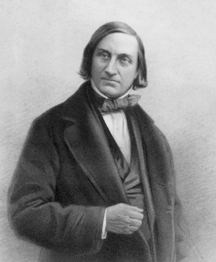Edward Forbes | |
|---|---|
 | |
| Born | 12 February 1815 |
| Died | 18 November 1854 (aged 39) Wardie, Edinburgh |
| Nationality | Manx |
| Alma mater | University of Edinburgh |
| Known for | Azoic hypothesis |
| Scientific career | |
| Fields | Natural history |
| Institutions | Geological Society of London King's College London Geological Survey of Great Britain Royal School of Mines University of Edinburgh |
| Author abbrev. (botany) | E.Forbes |
Edward Forbes FRS, FGS (12 February 1815 – 18 November 1854)[1] was a Manx naturalist. In 1846, he proposed that the distributions of montane plants and animals had been compressed downslope, and some oceanic islands connected to the mainland, during the recent ice age.[2] This mechanism, which was the first natural explanation to explain the distributions of the same species on now-isolated islands and mountain tops, was discovered independently by Charles Darwin, who credited Forbes with the idea.[3] He also incorrectly deduced the so-called azoic hypothesis, that life under the sea would decline to the point that no life forms could exist below a certain depth.
- ^ Egerton, III, Frank N. (1970–1980). "Forbes, Edward, Jr.". Dictionary of Scientific Biography. Vol. 5. New York: Charles Scribner's Sons. pp. 66–68. ISBN 978-0-684-10114-9.
- ^ Forbes, Edward (1846). "On the connexion between the distribution of the existing fauna and flora of the British Isles, and the geological changes which have affected their area, especially during the epoch of the Northern Drift". Memoirs of the Geological Survey of Great Britain, and of the Museum of Economic Geology. 1: 336–432.
- ^ Darwin, Charles (1871). On the origin of species (5th ed.). New York: D. Appleton and Co.